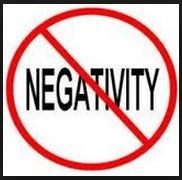Did you know that bad experiences affect us much more powerfully than good ones? Science has coined a term for this: negativity bias. The good news is that there are things you can do to counteract the effects of negativity bias by learning how to go on a low-bad diet.
January is Life Balance Month – a good time to take a look at what social scientists have learned about the significant effects that the imbalance of negative information and events have on our lives. Nearly 20 years ago, two psychologists reported findings about the impact of such imbalance. For example, bad health or bad parenting has a more profound effect on individuals than good health or good parenting does. A negative image stimulates more electrical activity in the brain than does a positive one. The pain of criticism is much stronger than the power of praise.
We don’t have to search far to find evidence that supports the results of these studies. Dozens of celebrities have recently announced that they’ve deleted their social media accounts because they simply were tired of all the negativity that was posted. Regardless of how many positive posts they receive, just one negative comment can ruin their day. A single word of criticism can be devastating, despite the shower of praise from many other fans.
The Evolution of Negativity Bias
Negativity bias is a psychological phenomenon by which humans react to bad things in life more strongly and persistently than to the good. Its origin harkens back to the caveman days when potential danger lurked behind every bush.
 Our ancestors’ brains evolved because negativity bias helped them to survive. The hunter-gatherers had to pay more attention to negative threats – like poisonous berries or predatory animals – than to the good things in life. Although this negativity bias can still be useful today, the threats are no longer the same as they once were.
Our ancestors’ brains evolved because negativity bias helped them to survive. The hunter-gatherers had to pay more attention to negative threats – like poisonous berries or predatory animals – than to the good things in life. Although this negativity bias can still be useful today, the threats are no longer the same as they once were.
Today we have different threats:
- Although it was useful for our ancestors to consume fattening foods in lean times in order to survive a drought, in today’s world the 24/7 availability of junk food has resulted in an epidemic of obesity, diabetes, and other health challenges.
- The news media taps into our primal emotions by hyping the threats of doom from nature, technology, ethnic and religious groups, and political rivals. The news instantly triggers the alarm circuits in our brains, which have evolved with a negativity bias that was originally designed to help us survive.
There are many ways in which negativity bias manifests itself. Here are a few examples:
- We remember criticism much more readily than we remember praise.
- Negative experiences stick in our memory longer and more vividly than positive ones.
- When your mind wanders, it’s more likely to recall something which made you anxious, angry or upset, instead of recalling something that made you feel happy.
The notion that bad events and emotions affect us more strongly than do positive ones may sound depressing, but it doesn’t have to be this way.
7 Tips to Counteract the Power of Negative Thinking
Although bad can be stronger than good, with conscious intention and the ability to make choices, good can prevail. Here are seven tips to help you stay on a low-bad diet.
1. Reframe negative thoughts into more positive ones.
Reframing involves changing your perspective on a given situation to give it a more positive or beneficial meaning to your life. Reframing can be used to help remove limiting beliefs, to help appreciate positive moments that you might otherwise miss, or  for letting go of negative thoughts and replacing them with positive ones.
for letting go of negative thoughts and replacing them with positive ones.
Your perception of reality is what creates your reality. The key to changing your reality is to practice realistic optimism by shifting your focus. Here’s an interesting exercise that exemplifies the power of focus:
- Tell someone your life story or a life experience as if it were a tragedy, emphasizing all the terrible aspects of that experience.
- Now, reframe by telling the same story as an uplifting and delightful experience, focusing on all of the positive aspects of that same experience, without denying the facts.
Notice how your perception of the same story changes by shifting your focus. If you’re unhappy with how you see life, reframe your negative thoughts. This will change your perspective so you can view your life through a different lens.
A good way to make a shift in focus is to ask yourself, “What can I learn from this?” Now, instead of having a problem, you have a way to improve yourself. Every challenge is also an opportunity to learn, so take advantage of it.
For a deeper dive on this topic, read my blog Is Negativity Bias Running Your Life?
2. Focus on what you want.
Whatever you focus on, that’s what you’ll get more of! In order to focus on what you want you must let go of thoughts that keep you focused on what you don’t want.
“I was once asked why I don’t participate in anti-war demonstrations. I said that I will never do that, but as soon as you have a pro-peace rally, I’ll be there.” –Mother Teresa
 Your language or self-talk is a very important part of this process. When you stop saying BUT and replace it with AND, you’re ready to shift your focus and reframe a limiting belief.
Your language or self-talk is a very important part of this process. When you stop saying BUT and replace it with AND, you’re ready to shift your focus and reframe a limiting belief.
Here’s an example: I hate my job, BUT I don’t have time to look for a new one…OR I hate my job, AND I’m actively seeking new ways of putting my talents to good use.
3. Carefully select the people you spend the most time with.
We become like the people we spend the most time with. Therefore, it’s important to limit input from negative people in your life. Do the people closest to you reflect who you want to be? Are they positive and uplifting? Do they support you and your goals? Are they achieving their own goals?
limit input from negative people in your life. Do the people closest to you reflect who you want to be? Are they positive and uplifting? Do they support you and your goals? Are they achieving their own goals?
“You are the average of the five people you spend the most time with.” – Jim Rohn
If you find yourself surrounded by negative, low-energy people who pull you down rather than lifting you up, reconsider who you’re allowing into your inner circle of influence.
4. Stop reading or listening to negative news and change your positivity ratio.
Devote the time you would normally spend on reading, watching, or listening to negative news by repurposing that time to focus on  self-improvement and things that are important to you. This shift will have a significant positive impact on your life.
self-improvement and things that are important to you. This shift will have a significant positive impact on your life.
If you want to change your positivity ratio, note that it takes four positive things to overcome one negative thing. For example, if you’ve been critical of a family member or co-worker, plan on giving at least four sincere compliments to help overcome the effect of your critical remark.
Another way to help change your positivity ratio is to practice this powerful rule: don’t sweat the small stuff. Pick your battles and let go of the rest.
5. Keep your commitments and promises.
You may pride yourself on the many good things you do for family, friends and people you work with. Sadly, what will be remembered is what you don’t do. In business and in life, you get very little credit for doing more than you promised, but you’ll pay dearly if you underdeliver or renege on your commitments. Be known as a person who keeps your promises.
6. Share good news.
 Sharing good news with someone who will celebrate with you is one of the most effective ways to become a happier person. Sharing it makes the win feel more significant, and it also anchors your happy feelings so they can be more easily recalled later.
Sharing good news with someone who will celebrate with you is one of the most effective ways to become a happier person. Sharing it makes the win feel more significant, and it also anchors your happy feelings so they can be more easily recalled later.
“To get the full value of a joy, you must have somebody to divide it with.” –Mark Twain
7. Think of all that you are grateful for and acknowledge it.
By definition, the practice of expressing gratitude involves a focus on the present moment, on appreciating your life as it is today.
The average person associates gratitude with saying thank you for a gift or benefit received. I invite you to consider a much broader definition.
Gratitude is appreciation for what you have; it’s looking at the bright side of a setback; it’s feeling abundance with whatever you have now; it’s thanking someone in your life; it’s  thanking God and counting your blessings. Gratitude is an antidote to negative emotions, a neutralizer of envy, hostility, worry, and irritation.
thanking God and counting your blessings. Gratitude is an antidote to negative emotions, a neutralizer of envy, hostility, worry, and irritation.
At the end of each day, take five minutes to focus on gratitude. You may find it helpful to write in a gratitude journal. Regardless of what kind of day you just had, you can always find something you are grateful for. This practice keeps you focused on what you want more of, rather than on what you don’t want.
You’ve just received seven ideas you can implement to help you go on a low-bad diet to counteract the power of negativity bias in your life. I encourage you to start with one idea you will take action on TODAY.
If you’d like to explore getting some support as you work toward changing your positivity ratio, let’s schedule a no-cost, no-pressure Discovery Call.
Additional Resources:
- Blog: Is Negativity Bias Running Your Life?
- Blog: Change Your Thoughts, Change Your Life!
- Blog: Science Proves that Money CAN Buy Happiness!
- Blog: Find Happiness and Success Will Follow – Part 1
- Blog: Find Happiness and Success Will Follow – Part 2
- Guide: Cultivating Happiness: Living Life on Your Terms
- Guide: Reclaim Your Power: How to Deal with Toxic People in Your Life & Business
- Guide: My Gratitude Journal

Life Architect – Creating Blueprints for Purposeful & Productive Lives
Kathy@OrgCoach.net www.OrgCoach.net Follow me on Facebook






Kathy, this is so good. Thank you for sharing and contributing to others. This is such a great reminder for me. Hope all is well with you.
Thank you, Miguel. Glad to hear that this blog has some good reminders that you find helpful.
Nice article, and it is a reality.
I like the title, low bad diet.
Keep on.
Yes, negativity bias is a real thing. The low-bad diet helps to make powerful shifts that create a healthier balance in our approach to life.
Excellent summary! The reality is that the “bad” weighs more, but can be managed and, in fact, make us stronger. Thanks for taking the time to put this together.